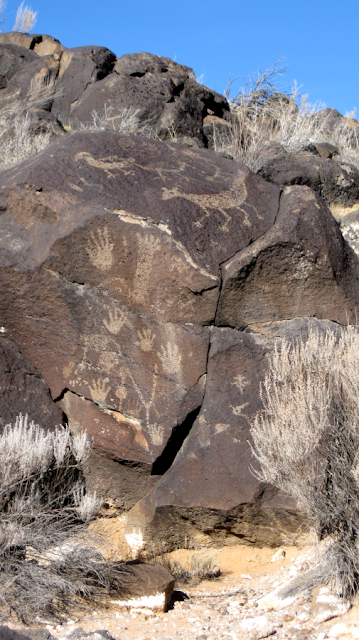Saturday, January 27, 2024
Zapatistas: the power of an Indigenous uprising in Mexico
Friday, January 26, 2024
Polydactyly
During my last of many visits to the Piedras Marcadas rock art site I noticed for the first time that there are several examples of hand representations with extra fingers. Such images are said to be common throughout the Southwest; the first time I saw an example of polydactyly was at the Three Rivers site north of Alamogordo. Feet with extra digits also appear frequently.
It is apparent from the frequency of appearance that extra fingers and toes held some special - possibly spiritual- importance to the indigenous people of the area. The juxtaposition of a six-fingered hand with a snake figure in my picture at the Three Rivers site suggests the possibility of a link with ceremonial snake handling.
Excavated burials have shown some support for the idea that community members with polydactyly enjoyed special status such as in this article from the National Library of Medicine:
...One can speculate if these individuals might have had a special role in their society. A burial of an infant with pedal polydactyly at Tapia del Cerrito in Arizona showed indications of importance [4]. The majority of burials at this site are under room blocks or in unused rooms. Few burials contain artifacts of any value. Positioning can also be a significant. This child was buried in the central plaza in an unusual clay-lined grave, faced northeast, and was accompanied by a type of pot rare in child burials. This child had special status, but the relationship to its polydactyly is unclear. There is also a report of a high status Freemont burial of a male with polydactyly, and the bifid metatarsals at Chaco were found in a major burial with turquoise and other valuables. There is also speculation linking the Chaco individual to the male found at Sand Canyon, based upon other congenital differences and similar rich burials [6]. A familial relationship would be an important factor in documenting the location of émigrés from Chaco after the society collapsed, and it may provide us with an idea about the rulers of the Ancestral Puebloan world...
Monday, January 22, 2024
The Root Cause
Friday, January 19, 2024
Piedras Marcadas
I went to the Piedras Marcadas rock art site primarily to make some pictures with one of my old Kodak folding cameras. However, knowing I would not be able to get close to many of the panels because of the rope barriers, I also took along my little Canon digital for a bit more reach with the 4x zoom.
There is an unexcavated Pueblo not far from this site. It is quite a way from the present course of the Rio Grande, but long ago the river wandered through the year all over the valley.
Monday, January 15, 2024
Sunday, January 14, 2024
Friday, January 12, 2024
New Digital
I got this nice little Canon Powershot A1000 IS on Craigslist for forty bucks.
The Canon is only a little larger than my ultra-compact Panasonic Lumix and has basically the same features, but also sports an eye-level viewfinder in addition to the screen. The optical viewfinder is zoomable, but does not have parallax correction, so one needs to use the screen for any closeup work. The camera is powered by two AA batteries. The dog and I took the camera for a test drive in the neighborhood.
Friday, January 5, 2024
Worthwhile Reading
Desmond describes some pretty amazing economic outcomes that accompanied the Covid pandemic which were overlooked by many of us who were focused on our own vulnerabilities at the time, and which have now been largely swept aside by other concerns of the moment. The opening lines of the review provide a good summary of the messages of the three books:
"In normal times, the United States stands out among advanced democracies for its high levels of poverty and its low levels of aid. In 2019, right before Covid struck, America’s relative child poverty rate resembled that of Mexico or Bulgaria. Then, during the pandemic, the federal government enacted three enormous and historic relief bills. These reduced child poverty by an astonishing 57.5 percent, more than doubling the government’s typical impact and suddenly placing the United States alongside Germany and Switzerland on this score..."
























